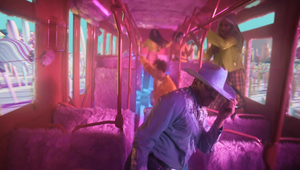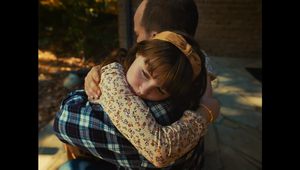
Why the Journey to Hair Growth Can Be the Journey to Life Growth

What does it take to create a poignant health ad? And, importantly, how does one demonstrate that good health practices begin with taking care of one’s hair? This was the challenge that Revolver Films director Janssen Powers found himself tasked with overcoming, when taking on the responsibility of creating a spot for the hair growth supplement Nutrafol.
Created in partnership with Sid Lee, the result was a black and white film capturing intimate moments in the lives of men - specifically, their decision to grow from exhausted, weary people into those actively seeking healthier living situations. Titled ‘Grow On’, the 30-second film ends with the reminder that while growth can begin with just hair, the journey itself may far transcend that.
To learn more about what it took to visually express this, LBB’s Josh Neufeldt sat down with Janssen, exploring the creative decisions that brought this work to life.
LBB> What was the script for this campaign like? What immediate ideas came to mind, and why was it something that you were keen to get involved in?
Janssen> I love the way that the creative team approached this script. From the beginning, it was clear they wanted to create something that felt bigger than a typical health ad. They were after something that not only told the story of growth, but also spoke to the reasons for WHY we pursue healthier lives.
As a director, I’m always drawn to scripts that use personal stories in ways that speak to something universal. So, that’s immediately where my head went when I received these boards. How could we capture intimate moments of growth in a way that spoke to something bigger?
LBB> What was the initial concepting process like? How did the idea for the spot evolve?
Janssen> When I pitch on a film, I like to ask creatives what kinds of things would make the project a success for them. By the time I’m invited to the process, their team has spent so much time with the creative, and I really value everything that they’ve discovered along the way. In this case, the team had such a strong vision for how the film should feel. They wanted the audience to be pulled into the narrative - connecting with the characters emotionally.
In pre-production, we invested a lot of time into creating on-set environments that would be conducive to capturing authentic moments. We knew if things felt real on the day, they would feel honest in the edit. We really placed a high priority on casting talent who were open to exploring the characters. We also selected locations that allowed our team to let the story evolve within the space.
LBB> Tell us more about the casting process! What were you looking for?
Janssen> Casting has become my favourite part of the filmmaking process. In casting, I’m always looking to connect with collaborative and inventive actors. As a director, I work hard to create environments on set that make space for genuine emotion, so it becomes really important to ensure we cast the right actors for each environment.
For me, callbacks are such a vital part of the process. Within the short window of time I get with each actor, I really try to listen to what they’re uniquely bringing to the role. Commercials can be so fast-paced, so callbacks are a great opportunity to explore how we can work together to bring a character to life.
In this project, I was specifically looking for actors who could capture the emotional evolution within a character. This film is about consciously choosing health, so in both macro and micro ways, it became important to cast actors who could give the audience a glimpse into how it feels before, during, and after the character makes this conscious decision.
LBB> This is the brand’s first ever campaign shot on film. What made this the right medium for the job, and why did you opt for the black and white aesthetic?
Janssen> A lot of my work is shot on film. I really enjoy the aesthetic, especially when working on Super 16!
I also really enjoy how shooting on film affects the environment on set. As a director, it forces me to prioritise rehearsals, especially when it comes to blocking. In my experience, the more dialled we are before the camera rolls, the more there is to explore during the actual take. When everyone in front of and behind the camera is on the same page, we can all begin to explore the little nuances that make a character/scene/story feel alive.
From the beginning, the team at Nutrafol decided that black and white was the right aesthetic for this project. This was my first experience shooting entirely on black and white film, and I really enjoyed the process. Our DP, Farhad Ghaderi, our production designer, Hope Little, and I talked a lot about how the aesthetic informed our compositions. The lack of colour heightened the attention to the geography in a space and the light in a room.

LBB> How long did it take to shoot, and what was the experience like?
Janssen> We spent two days making this film. We had a lot of setups to capture - so our schedule was packed - but we had an incredible team.
Specifically, shooting in Toronto was a big benefit in this regard. Not only is it one of my favourite places to work, but the team at Revolver has built trust with the filmmaking community in the city, which goes such a long way.
The teams at Sid Lee and Nutrafol were also a joy to work with. They were collaborative and creative. They brought so much energy to the project and really pushed to make it the best it could be.
LBB> Tell us more about shooting in Toronto. Where all did you shoot, and how did you approach capturing these locations?
Janssen> In a project like this, I think it’s important to minimise time spent in transit, and maximise time spent on set. Here, the wide variety of locations added a lot to the project's scope, so we didn’t want to compromise on the number of looks - but we also wanted to capture as much as possible within our two-day window.
With all of this in mind, we landed on two locations (one location per day) that would give us a variety of looks. Our first day was spent at a really unique house in Toronto. The house had a ton of character and gave us five or six distinct looks.
Our second day was spent at a community centre in Toronto. We scouted a handful of different options, but, like the house, the location we landed on felt unique and versatile. We filmed the track scene, pool scene, gym scene, and most of the portraits at this community centre.
LBB> How did you approach capturing the action shots? Did you bring any special equipment to make this easier?
Janssen> The action shots in this film are essential to the story. They add energy to the piece and also provide a visual device to communicate the emotional evolution within a character.
Instead of specific shots, we tried to approach these action moments as sequences. A few scenes were filmed exactly as they were storyboarded, like the opening scene of the man on the track, but for the most part, we wanted to capture enough to give the team options in the edit. For example, instead of a single, overly prescribed shot of a man swimming in a pool, we filmed an entire swimming sequence. We did our best to let the action and environment inform the shot, versus allowing the shot to dictate the action and environment.
LBB> The sequence of shots following the man before he flops on his mattress is super memorable. How did you bring this to life?
Janssen> To accomplish this sequence, we used a camera mount called a SnorriCam. This camera mount attaches directly to an actor's body, which keeps the distance between the actor and the camera consistent.
Keeping the actor in the same part of the frame allowed us to draw attention to how he changed over time. As he moved from environment to environment, the stress of his day weighed more and more heavily upon him.
In each environment, our SnorriCam-wearing actor spun quickly in a counter-clockwise direction. These rapid movements blurred the background, allowing us to cut seamlessly between worlds within the edit.

LBB> Are there any elements of the project you’re particularly proud of? And why?
Janssen> I’m proud of how this film tells the story of growth. Growth doesn’t just happen on its own. I think it requires us to become active participants. It’s a choice. To this end, I feel like there’s so much power in this conscious decision to grow, and I’m really proud of how these simple human moments of growth shine through in the edit.
I’m also really proud of the visuals. Farhad and Hope brought so much to this project. They and their teams made the film look as incredible as it does. As a director, it’s difficult to describe how exciting it feels to look at a monitor on set and see the stories coming to life in real time.
LBB> What challenges did you face during production, and how did you overcome them?
Janssen> I think the biggest challenge during production was ensuring we could make space to capture honest/emotional moments, despite the busy schedule. Film production can move so fast - especially in commercials - and in my work, I’ve always found that it’s important to be intentional about creating space.
Authenticity is something that needs to be protected, not manufactured. It’s kind of like growth. It doesn’t just happen. When we are intentional about making space to listen, more often than not, these beautiful little moments naturally emerge on set.
LBB> Is there anything you’d like to add?
Janssen> I can’t thank Nutrafol and the Sid Lee team enough for trusting me with this one. I felt so empowered throughout the entire process. Their collaborative energy set the tone for the whole project. They gave the entire team permission to think outside the box and really prioritised making something memorable.
I’d also like to thank the cast and crew who brought the film to life! My favourite part of filmmaking is that the films we make reflect the people who make them. It’s the ultimate team sport. There’s something special about a group working together to capture something real. The moments on set when everything comes together - when everyone’s work comes to life on screen… there’s truly nothing like it.












